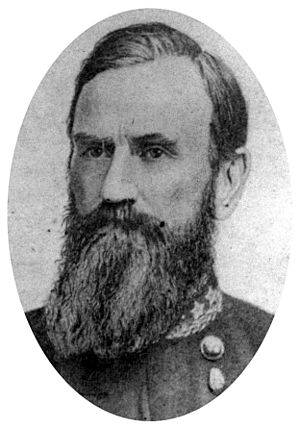Benjamin G. Humphreys facts for kids
Quick facts for kids
Benjamin Grubb Humphreys
|
|
|---|---|

General and Governor of Mississippi
|
|
| 26th Governor of Mississippi | |
| In office October 16, 1865 – June 15, 1868 |
|
| Preceded by | William L. Sharkey |
| Succeeded by | Adelbert Ames |
| Member of the Mississippi Senate | |
| In office 1839–1844 |
|
| Personal details | |
| Born | August 26, 1808 Claiborne County, Mississippi Territory |
| Died | December 20, 1882 (aged 74) Jackson, Mississippi |
| Political party | Democratic |
| Signature | |
| Military service | |
| Allegiance | |
| Branch/service | |
| Years of service | 1861–65 |
| Rank | |
| Commands | 21st Mississippi Infantry Regiment Humphreys' Brigade |
| Battles/wars | American Civil War |
Benjamin Grubb Humphreys (August 26, 1808 – December 20, 1882) was an important American politician from Mississippi. He served as a general in the Confederate States Army during the American Civil War. After the war, he became the Governor of Mississippi from 1865 to 1868, during a period called Reconstruction.
Contents
Early Life and Education
Benjamin Grubb Humphreys was born in Claiborne County, in the Territory of Mississippi. He received his education in New Jersey. Later, he enrolled at West Point, a famous military school. He was in the same class as well-known figures like Robert E. Lee.
However, Humphreys was expelled from West Point in 1826. This happened after he took part in a "Christmas frolic." This event turned into a large disturbance known as the Eggnog Riot.
After leaving West Point, Humphreys returned to Mississippi. He was elected to the state senate, representing his home county. He served as a senator from 1839 to 1844. In 1846, he moved to Sunflower County, Mississippi. There, he helped establish the town of Itta Bena and developed a cotton plantation.
Service in the Civil War
When the American Civil War began in 1861, Humphreys quickly joined the Confederate States Army. He raised a group of soldiers and was made a captain. Soon after, he was elected to the rank of colonel for the 21st Mississippi Infantry Regiment.
His regiment was part of a larger group led by Brigadier General William Barksdale. They fought in the Eastern Theater of the war. During the Battle of Gettysburg in 1863, Humphreys's regiment attacked Union positions. They pushed the defenders back toward Cemetery Ridge.
After General Barksdale was killed, Humphreys took command of the brigade. He was then promoted to brigadier general. He remained in command until he was injured in the Battle of Berryville, Virginia, on September 3, 1864. Humphreys went back home to Mississippi to recover. However, he was not able to return to active duty before the war ended.
Political Career as Governor
After the Confederate Army surrendered, many Southern politicians and army officers were not immediately forgiven. They were also not allowed to hold public office. When Benjamin Humphreys decided to run for governor, he had not yet received a pardon. President Andrew Johnson did not want him to be elected.
Despite this, Humphreys refused to stop his campaign. On October 2, 1865, he was elected as a Democrat. He was not immediately recognized as the official Governor of Mississippi. However, on October 16, 1865, Humphreys went ahead and was sworn in as the 26th Governor of Mississippi.
By October 26, 1865, the temporary Governor of Mississippi, William L. Sharkey, received a pardon from President Andrew Johnson. This pardon allowed Humphreys to hold political office under the Reconstruction plan. Humphreys won re-election in 1868 and began a second term. However, with the start of stronger federal control during Reconstruction, he was physically removed from office by U.S. armed forces on June 15 of that year.
As a Democratic Governor, Humphreys held views common for his time regarding race. He believed that while African Americans were free, they were not equal to white people in terms of citizenship or social standing. These views reflect the widespread racial inequality that existed in the United States during the 19th century.
Later Life and Legacy
After his time in politics, Humphreys started a career in insurance in Jackson, Mississippi. He worked there until he retired in 1877. He then moved to his plantation in Leflore County, Mississippi, where he passed away in 1882. He is buried in Wintergreen Cemetery, located in Port Gibson, Mississippi.
Humphreys County, Mississippi, is named after him. His son, also named Benjamin G. Humphreys, followed in his footsteps and became a politician. The younger Benjamin G. Humphreys served as a Congressman. He was very important in adding levees (river banks) to the charter of the Harbors and Rivers Committee, which helped control flooding.

